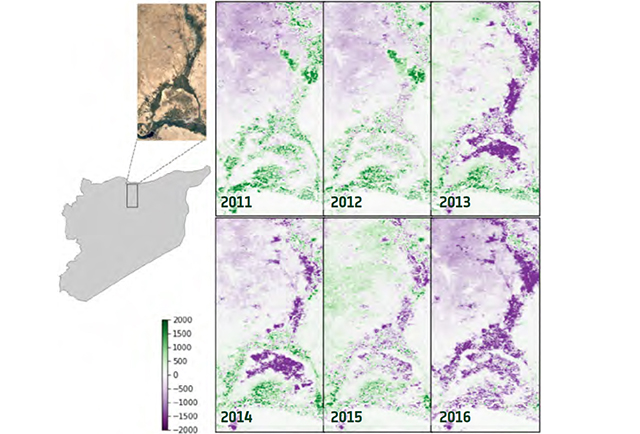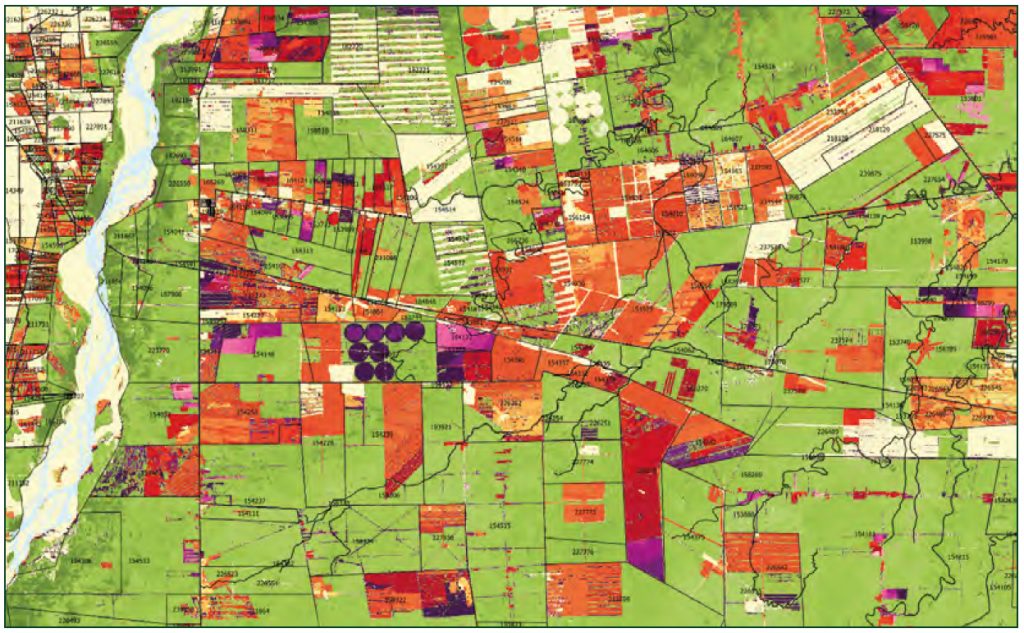Posted on October 25, 2017 by Mariangela
Welcome to a new phase of the Agriculture initiative
A high-level Stakeholder Consultation meeting took place in Frascati (Rome) marking the conclusion of Phase 1 of the EO4SD-Agriculture and Rural Development project and welcoming representatives from the key Multilateral Development Banks and aid organisations involved in EO4SD initiative.
Satellite Earth Observation (EO) has tremendous potential to support the implementation of long-term and large-scale development programs resolving the data and information gaps concerning agriculture issues: the status and change in land use, the agricultural production, and the resilience for food security, among many other aspects. The European Space Agency (ESA), together with the European industry, cooperates with Multilateral Development Banks (MBDs) and their client countries to harness the benefits of EO for agriculture and rural development. After more than one year of cooperation in the frame of the Earth Observation for Sustainable Development (EO4SD) ‘Agriculture and Rural Development Cluster’ project, ESA hosted a high-level Stakeholders Consultation meeting marking the conclusion of the first phase of the project. The meeting took place on 6 October 2017 at the ESA ESRIN premises in Frascati (Italy) gathering representatives from the main International Financial Institutions (IFIs).
The meeting was dedicated to present the state-of-art EO capabilities for the agricultural sector and to demonstrate to invited IFIs and development organisations how their projects and investments can be significantly enhanced by using EO-derived information.
EO4SD cluster members delivered presentations on the current cooperation between the project and MDBs, focusing on how these activities are supporting sustainable land management and food security in Ethiopia, the mapping of agriculture and irrigations systems in selected Cambodian provinces, and the monitoring of environmental impact of palm oil commodities expansion in Uganda, among other use cases.
One of the key presentations focused on the contribution of the cluster to a report conducted by the World Bank for assessing agricultural losses resulting from the Syrian armed conflict. The cluster presented how technical assistance was provided to map temporal and spatial changes in land cover and agricultural productivity in the country. Following this presentation, Bekzod Shamsiev, Senior Agriculture Economist of the World Bank, referred to this study as “incredibly useful” and reported how the World Bank “gained a lot from the practical project implementation perspective to understand the agriculture sector resilience, revival potential, and food production capacity in Syria.” “The analysis provided by the EO4SD Cluster revealed a number of indicators that can be derived from satellite data and used in informing decisions where reconstruction investment could take place, and to identify locations for possible assistance”. Going forward the World Bank reaffirmed its intention to work with ESA and consortia to apply these experiences in other countries as well.

Absolute change in biomass production from 2011 to 2016 as compared to 2010 (in kg/ha/year) (input data: 250m annual Above Ground Biomass Production from the FAO WAPOR database) extracted for Al Raqqah, Syria.

Deforested areas derived from time-series analysis of Sentinel-1 radar and optical Sentinel-2 and Landsat imagery. Black lines: land title database courtesy of INRA Bolivia. Example from Santa Cruz, Bolivia.
The representatives from the World Bank (WB), the Asian Development Bank (ADB), the International Fund for Agricultural Development (IFAD), Conservation International, the Global Agriculture & Food Security program (GAFSP), the World Food Programme (WFP), the Inter-American Development Bank (IaDB), the World Agroforestry Centre (ICRAF) and the Food and Agriculture Organization of the United Nations (FAO) were invited to take part in the consultations and to provide with feedback and advice regarding the proposed EO services and the roles and opportunities of IFI partners during the upcoming services implementation and capacity building activities.
One of the first discussions of the participants revolved around the United Nations Sustainable Development Goals (SDGs) and how Earth Observation can help to achieve the 17 goals that will transform our world. Nichola Dyer, from GAFSP, made a valuable reflection on the importance of interconnecting the topics of the EO4SD project such as land degradation, deforestation and agriculture in general with the different SDGs. In addition, Talip Kilic, Senior Economist at the World Bank, invited the consortium to complete a review of SDGs indicators and define how Earth Observation technology can actually contribute and get involved in the SDGs monitoring.
The session included also a presentation delivered by a representative from the WFP, Rogerio Bonifacio, who shared experiences from the use of Sentinel-1 and Sentinel-2 for food security mapping in countries such as Uganda and South Sudan with the audience. In addition, Jippe Hoogeveen from FAO presented FAO WaPOR, the FAO portal to monitor water productivity through open access to remotely sensed derived data and operational provision of biomass information.
Roundtables: shaping the future of the EO4SD activities
Four roundtables held during the one-day session gave the opportunity to the participants to look at the future of the project and the opportunities for using satellite information and data in sustainable development programs as well as the upcoming capacity building activities.

IFI experts provided advice and guidance to ESA and the EO4SD-Agriculture and Rural Development cluster on how to further scale up cluster activities in the upcoming Phase 2, running from 2017 to 2018.
Keith Garret from the World Bank put on the table one of the backbone ideas showcased during the session: the value of EO data is in the number of users. “We have a lot of information that was not available before and we have to remove barriers between users and EO data”, he emphasised.
Alice Ruhweza, from Conservation International, highlighted the lack of capacity in many countries. For this reason, she received very positively the commitment of the cluster regarding capacity building activities. “It is needed to scale the EO4SD activities to several actors including Ministers and Governments as well as to define where EO data fit in, to find the “entry point” for engagement, and to follow-up how actors implement EO4SD services in their activities”.
Other insights on the capacity building activities were shared by the IFAD representatives. Amath Pathe Sene underlined that satellite-derived information and capacity building might be crucial for integrated policies implementation. “Information from EO4SD services should be combined with our operations across sectors and the results used by IFIs that need a full vision of the projects and investments”, he added. In addition, he encouraged the cluster to target universities that are training the future leaders, and to offer training in the local language. Then, Eric Patrick remarked that “the consortium should conduct a deep assessment of the capacity in the selected countries” and expressed that [IFAD] “is willing to hold capacity building sessions at IFAD headquarter”.
Another stakeholder perspective was shared during the discussion by Talip Kilic from the World Bank. He advised the cluster to define and align “incentives” that can help to overcome a fundamental constraint that prevents a wide adoption of information services such as human resources available in institutions up-taking capacity building activities. “Cultivating expert staff in these institutions is needed to help them achieve a recognition within an institution and obtain resources to carry out their tasks. This can only be solved by political engagement to make an impact” he noted emphasizing that “this is an area to be tackled because it will dictate what one can get out of the capacity building activities”.
Erick Fernandes, Science Advisor to the Senior Director of Agriculture Programs from the World Bank, reported that “increasingly transparency and real-time observations are underpinning the WB’s discussions with their Client States”. The World Bank is putting increased emphasis on Payment for Results programs. “Weather it is a public sector and taxpayers or private sector and investors they are very concerned about robust, reliable and current information.There is a tremendous opportunity for ESA platforms such as Sentinels and others to be applied to the challenges that are emerging: bringing reliability and information to our lending programs. World Bank operates in 174 countries from Afghanistan to Zambia and in many countries that we operate, or lend for, there is an interest in this kind of information.”
Nichola Dyer, from GAFSP had also positive words about the ESA programme and she referred to the project as an important initiative which offers a remarkable added value to Multilateral Development Banks’ and aid organisations’ activities.
All presentations of the meeting are available below:
- EO in support of Sustainable Development Agenda
- EO4SD-Agriculture and Rural Development project
- Agriculture expansion impact on deforestation in Bolivia and Paraguay
- Management and evaluation of rural development and sustainable land and forestry projects in Burkina Faso
- The potential of EO for irrigation systems management and agricultural production assessment in Cambodia
- Earth Observation in support of sustainable land management and food security projects in Ethiopia
- EO4SD contribution to the Green Morocco Plan
- Multi-scale monitoring of land degradation and food security in the African continent
- Satellite Earth Observation to assess the consequences of armed conflict on agriculture sector in Syria
- Agricultural production changes as a result of IFI project interventions in Uganda
- Monitoring Water Use in Agriculture by remote sensing
- Experiences from the use of Sentinel 1 and Sentinel 2 for food security mapping in Uganda and South Sudan
- Capacity Building outlook.


